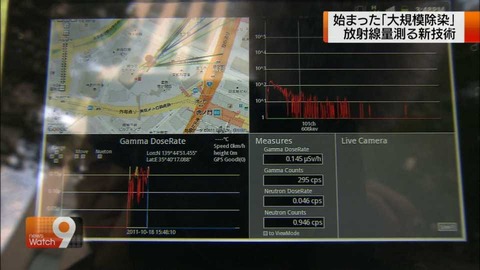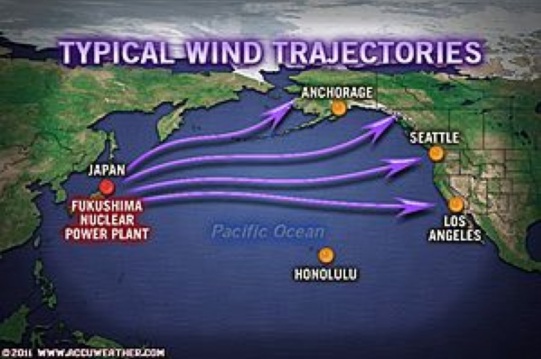Nuclear fallout: Neutron ray measured in Tokyo – “Uranium 235 all around”

Fukushima-diary reports that a neutron ray was measured in Tokyo. Neutron ray is emitted from Uranium 235 wich came from MOX with Plutonium and can not be measured by most of the Geiger counters.
It’s way more harmful to human body as neutron radiation is most severe and dangerous radiation available!
According to the worst pro-nuc safety standard ICRP60:
- Tumor risk: 3~200 times higher than gamma ray
- Possibility to shorten your life by cancer: 15~45 times higher than gamma ray
- Genetic transformation: 35~70 times higher than gamma ray
- Chromosomal abnormality: 40~50 times higher than gamma ray
- Genetic impact for mammal: 10~45 times higher than gamma ray
Screen shot of the moment when they measured it in a car, around Toranomon, where is near Tokyo tower.(10/18/2011)
Before March 11th the average neutron ray was 4 nSv/h. After, it’s 464 nSv/h (116 times higher than before).
Citizens detected Uranium 235 in one of the worst hot spots in Chiba, Kashiwa shi. It was right beside a bench in Matsuba daiichi kinrin park.
10/11/2011 9:40 AM ~ 10:30 AM
1.2 m high from the ground
- Background 0.372 μSv/h
- 80.0 keV, Unsorted type of radioactive material = 254 Count
- 191 keV, LEU(low enriched uranium = 180 Count
- 594 keV, Cs-134 = 221 Count
- 655 keV, Cs-137 = 208 Count
15 mm high from the ground
- Background 0.628 μSv/h
- 30.2 keV, Cs-137 = 621 Count
- 188 keV, LEU(low enriched uranium = 156 Count
- 594 keV, Cs-134 = 467 Count
- 654 keV, Cs-137 = 412 Count
In Kashiwa, even from the height of 1.2, they can measure Uranium 235.
Now Uranium 235 is all around in Tokyo, which came from MOX with Plutonium.
They keep emitting neutron ray. Source: fukushima-diary.com
Health hazards and protection
In health physics neutron radiation is considered a fourth radiation hazard alongside the other types of radiation. Another, sometimes more severe hazard of neutron radiation, is neutron activation, the ability of neutron radiation to induce radioactivity in most substances it encounters, including the body tissues of the workers themselves. This occurs through the capture of neutrons by atomic nuclei, which are transformed to another nuclide, frequently a radionuclide. This process accounts for much of the radioactive material released by the detonation of a nuclear weapon. It is also a problem in nuclear fission and nuclear fusion installations, as it gradually renders the equipment radioactive; eventually the hardware must be replaced and disposed of as low-level radioactive waste.
Neutron radiation protection relies on radiation shielding. In comparison with conventional ionizing radiation based on photons or charged particles, neutrons are repeatedly bounced and slowed (absorbed) by light nuclei, so a large mass of hydrogen-rich material is needed. Neutrons readily pass through most material, but interact enough to cause biological damage. Due to the high kinetic energy of neutrons, this radiation is considered to be the most severe and dangerous radiation available. The most effective materials are e.g. water, polyethylene,paraffin wax, or concrete, where a considerable amount of water molecules are chemically bound to the cement. The light atoms serve to slow down the neutrons by elastic scattering, so they can then be absorbed by nuclear reactions. However, gamma radiation is often produced in such reactions, so additional shielding has to be provided to absorb it.
Because the neutrons that strike the hydrogen nucleus (proton, or deuteron) impart energy to that nucleus, they in turn will break from their chemical bonds and travel a short distance, before stopping. Those protons and deuterons are high linear energy transfer particles, and are in turn stopped by ionization of the material through which they travel. Consequently, in living tissue, neutrons have a relatively high relative biological effectiveness, and are roughly ten times more effective at causing cancers or LD-50s compared to photon or beta radiation of equivalent radiation exposure.
Neutrons also degrade materials – bombardment of materials with neutrons creates collision cascades that can produce point defects and dislocations in the materials. At high neutron fluences this can lead to embrittlement of metals and other materials, and to swelling of some of them. WikiPedia
About Neutron ray: Neutron ray is particulate ionizing radiation consisting of neutrons. On impact with nuclei or atoms, neutrons possess enough kinetic energy to set the nuclei or atoms in motion with sufficient velocity to ionize matter or enter into nuclear reactions that result in the emission of ionizing radiation. The former variety is usually called the fast neutron, and the latter the thermoneutron, with gradations of epithermal and slow neutrons between them.
Fukushima nuclear disaster was and is a global threat
Alexander Higgins wrote back in may 2011:
As plutonium and uranium concentrations in the US hit their highest levels in 20 years a top nuclear physicists says most of the plutonium MOX nuclear fallout from Fukushima will drop on the United States.
In an interview with the Huffington Post, Nuclear Engineer Akira Tokuhiro, says most of the plutonium mox fuel nuclear fallout from the Fukushima nuclear power plant will likely drop on the United States.
Throughout the article the engineer slams other nuclear experts for covering up the true extent of the Fukushima nuclear disaster for the sake of saving their own jobs, clearly saying the bottom line is they can not be trusted.
…
The most terrifying fact is that the Japanese power plants are using ‘dirty’ fuel, which most countries have rejected and banned. Needless to say that the Americans built them. Since the Earth is moving Counterclockwise most of the fall-out will drop on U.S., unless very strong winds take it somewhere else.
…
Plutonium fallout was first detected hitting the United States on March 18th


Sadly you are right. But its not just Japan… consequences are huge for entire Earth no matter how hard they try to keep us in the dark. And in the world where alternative power sources are available using nuclear energy, at the excuse of “high cost”, is plain wrong.
I would say that Japan is pretty much done for. It will never recover, because even if they rebuild, much of their population will either become sick or die from the radiation contaminants…within 20 years or so, they will have a drastic drop in population. It is heartbreaking, but that is the price of playing around with something as dangerous as nuclear reactors. Nuclear power may seem to be “safe” if precautions are followed, but when accidents happen (which will, despite all precautions) the damage is extensive and long-term.